#with a focus on fashion and costume history
Text
Actually, @lightandfellowship asking about other Dark Road historical fashion thoughts on this post did kind of get me thinking about it and you know what I think is really interesting? Is that there are only two students that are at any point wearing entirely Western-looking (non-Japanese) clothing without an obi and obijime, and that’s Xehanort (pre-arrival at Scala)...
And Baldr.
Even Master Odin is wearing an obi and obijime despite otherwise dressing like Gandalf, but we’ll leave him aside for the sake of this discussion.
For the most part the students are wearing fusion clothing, but that’s typical of the Taisho era. The Taisho period, which immediately followed the end of the Meiji Restoration, was a period of great change in Japan, and of Westernization. It was very common for people to wear a mix of Western clothing with traditional Japanese clothing. You can see a lot of this in the Dark Road students;
(This got really long lol. Discussion of the secondary and tertiary Dark Road students’ design choices, culminating in discussion of Eraqus, Xehanort, and Baldr’s designs and what they might mean in the context of a Taisho-period-adjacent setting, under the cut).
- Most of the male students, plus Urd, are wearing very loose, bloused pants, probably tobi trousers or karusan-bakama.
- Vidar, Vali, and Vala have some of the most traditionally Japanese silhouettes among the upperclassmen. Vidar is wearing a sleeveless lapped garment that isn’t strictly traditional, but has a very Japanese look to the way it’s assembled and to the color styling, while Vali is wearing pretty authentic-looking Japanese faulds, and is obviously supposed to make you think of the kabuki ideal of a ninja. Vala also looks EXTREMELY Taisho-period; the wearing of silk-painted or embroidered, brightly-colored hakama with an obi and furisode or kosode was extremely common for girls in the Taisho period. Vala has some sort of fantasy puff cuff-sleeve-thing instead of furisode, but her hakama and obi are lifted straight out of the 1910s. Interestingly, these upperclassmen, like Eraqus in the lower class, survive the longest.
- Heimdall, Sigrun, and Bragi are all wearing a mix of actual traditional Japanese clothing and Western elements. They are all wearing short kimono, with Sigrun having a very classic obi styling, Bragi is wearing traditional workman’s clothing (a hanten and sarubakama, with an obi without obijime, interestingly), and Heimdall appears to be wearing a kosode, with obi and obijime. However, Sigrun is wearing leggings and gaiters, Heimdall has some WILD thigh-high Three Musketeers boots and that very intensely high-collared, French-looking bolero jacket, and Bragi is, as previously discussed, wearing a bomber jacket (and also Chuck Taylor sneakers, Bragi you sneaky, deeply anachronistic guy).
- Helgi and Hoder, interestingly, appear to be blending Japanese and Chinese clothing styles; they’re both wearing obi and obiage, but Hoder appears to be wearing a cheongsam, and while Helgi is wearing a sleeveless kimono as a shirt, his fur ruffs very much evoke some traditional theatrical depictions of Son Goku (the Monkey King not the DBZ character); but I’m not that knowledgeable about Chinese clothing so I won’t make too many conjectures here.
- Urd and Hermod and Vor all have very fantasy-like designs, with the girls having fewer garments from either real Western or Japanese styles. Hermod and Urd as discussed have the bloused pants, Vor’s coat looks VERY much like a traditionally silk painted kimono that’s been altered to have a Western tab-collar, but has a traditional Japanese rope bow on the back, and all three are wearing obi and obiage. However, Urd’s robe/cape thing is VERY Western Fantasy Wizard, meanwhile Vor is wearing actual pumpkin pants. Hermod’s looks the most period, with his haori retaining the traditional lapels but altered to have Western bishop sleeves, and he’s wearing VERY WWI-style gaiters.
Now lets talk about the other three, who are actually our main characters; Xehanort, Baldr, and Eraqus.
Eraqus is absolutely wearing nothing but traditional Japanese clothing (aside from the obvious Kingdom Hearts elements of the turtleneck and crossed suspenders). He is wearing extremely traditional hakama, with the most traditional haori of any of the cast. His hair is partially loose but what is pulled back is pulled into something like a topknot; Eraqus is designed in every way to evoke the look of the samurai class. What I think is significant with that is that, as mentioned, the Taisho period followed the Meiji Restoration, when the samurai class in Japan were more or less disbanded in the face of modernization of Japan. I don’t think it’s unrelated that at this point, the Scalan society that considers Eraqus a ‘blueblood’ is also in decline, and is ultimately ended within Eraqus’s lifetime. He is the last of his kind, and he is dressed like it.
Then, there’s Xehanort. When he leaves Destiny Islands to go to Scala he’s dressed in an outfit that calls to mind Ephemer’s, and is extremely Western and modern-looking; which makes sense, since he was raised by Player, and the KHUX time period has very modern and Western fashion (remember Bragi’s Chucks?). But once he’s a student, he’s replaced his button-down shirt and collared sleeveless duster with a turtleneck (Kingdom Hearts, lol) and haori of his own, an exact photo negative of Eraqus’s haori except that Xehanort’s is sleeveless. But Eraqus is a blueblood, and as far as anyone in Scala knows, Xehanort is a nobody and a foreigner; he is still wearing Western pants in a Western style, held up by a Western belt and without any obi in sight. Xehanort was born in Scala, and he resents being seen as Just Some Guy, but he doesn’t belong there like Eraqus does; his haori on top is trying to make him part of that world, an equal to Eraqus, but what’s underneath reflects that Scala doesn’t consider him either of those things.
And then, there is Baldr.
I’ve seen other posters point out that his clothing is all black, under a white jacket (I’m sorry I don’t remember who pointed this out!), but also, Baldr has the most Western and contemporary clothing of all of the characters in Dark Road. In contrast to Xehanort, with his loose, pre-WWI-era jeans, Baldr is wearing contemporary skinny jeans with a wallet chain and fashionable low-buckled boots. He’s also wearing a waistcoat, and a bolero jacket with what looks like knit cuffs. He doesn’t fit in with the others at all, even less than Xehanort does.
And pointedly, like Xehanort, he is not wearing an obi.
I feel like it’s not a coincidence that this game visually sets its characters in the Taisho era, the time period that transitioned Japan from the traditional Japan to the modern, Westernized Japan of the 20th century, and the character who puts a permanent end to Scalan society is the only character dressed entirely in Western and modern clothing. Obviously I can’t say for sure what the intent was, but at the end of the game, the three characters left standing are Eraqus, dressed in the most traditionally Japanese fashion, Baldr, dressed in the least, and Xehanort, the fusion, who is dressed like Eraqus on the surface, but underneath, is dressed like Baldr.
#KHDR#Kingdom Hearts#Kingdom Hearts Dark Road#long post#related to; fashion history#In case this seems like talking out of my ass lmao my qualifications are I have a degree in fashion#with a focus on fashion and costume history#did my final graduating paper on how modern Japanese street fashion#was influenced by Meiji and Heian and Taisho fashion#and also worked as a professional costumer for the theater industry for several years#Butttt it's been a little bit so there may be inaccuracies#but these are my thoughts from like. A costume design perspective and how costumes inform character for narrative purposes
35 notes
·
View notes
Note
I’m so sorry if you’ve already answered this somewhere, but how do you design your characters?
I’ve been trying to make an OC from the prohibition era and it turns out there’s basically nothing to work with for men’s outfits, so I’m curious how you made this many that look unique and fitting to the characters
There is so much to work with, though!
You will tend to find more of a focus on variety in women's fashion, but there is still quite a lot of menswear to ogle too.
I suppose it's just a matter of searching out ideas and inspiration in the rights corners. Here are a few suggestions:
Old Clothing Catalogues -
Collections from Sears-Roebuck and other popular clothing retailers are pretty easy to find compiled into relatively inexpensive books, or just floating online.
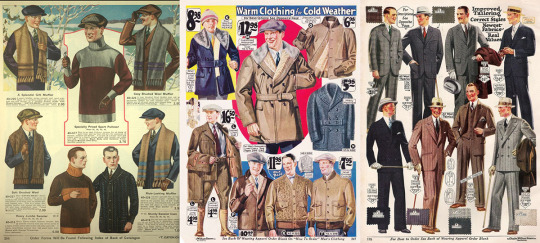
A fair bit of it is in the public domain now.
--Here's an entire 1922 catalogue of stuff to flip through.
-----------------
Contemporary Artwork -
Some phenomenal illustrators were working in this field amidst the "Golden Age of Illustration" and featured prominently on the covers of magazines and on the ads inside. There was a lot of emphasis on fashion.

Collier's and The Saturday Evening Post are a couple of the more prominent and easily searchable resources. The costuming on the cover art always has a lot of personality.
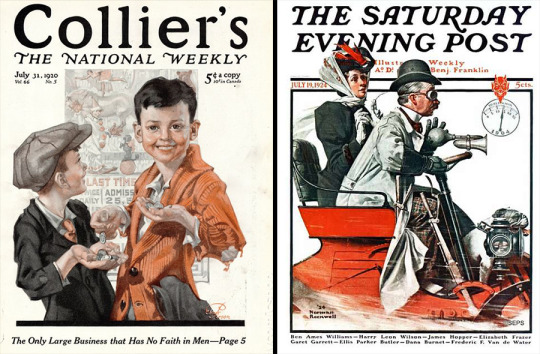
There's Rockwell, of course, and it's almost impossible to go wrong with J. C. Leyendecker. He's probably best known for his Arrow Collar ad art, but even his sock ads are like…
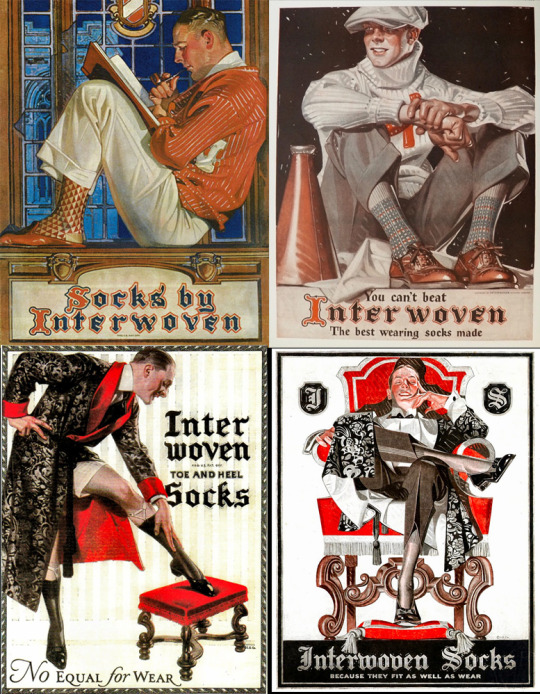
There were numerous other amazing and influential illustrators working at the time too. Here's a list of some of them.
Here's a bonus Henry Raleigh featuring some of his fabulously-dressed people.
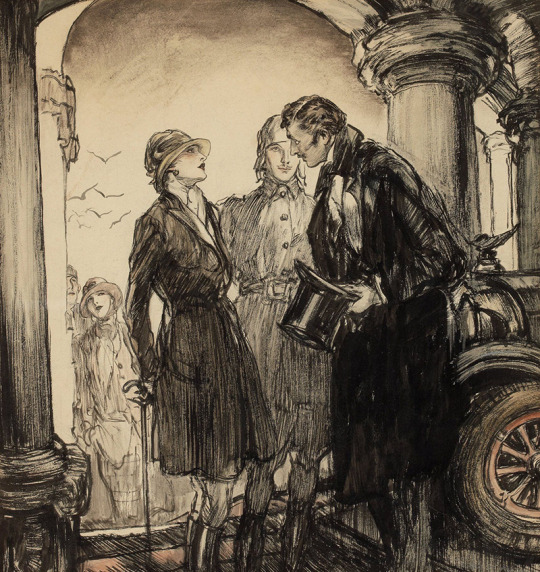
-----------------
Blogs and Articles -
There are so many of them!
If you want historical accuracy, be wary of write-ups pulling all of their references from film and television. There's nothing wrong with using those for inspiration if you aren't too concerned with historicity, but there are some pretty comprehensive and well-researched things out there with more of an eye on actual fashion history too:
--Gentleman's Gazette - What Men Really Wore in the 1920s
--The Fashionisto - 1920s Men's Fashion
-----------------
Digital Collections -
There are numerous digital historic image collections stemming from universities, museums, libraries, and the government that are free to peruse too.
--The Metropolitan Museum has a searchable catalog of exhibits that includes fashion and photos
--Here's some things from the New York Public Library
-----------------
Photos at Large -
If you aren't sure where to start, image searching for any of Hollywood's early celebrities will typically turn up a bevy of production stills and promotional photography featuring a variety of fashions.
Here's a random Getty images search for Harold Lloyd. A lot of standard 3 piece suits, but a lot of stuff with added character too.
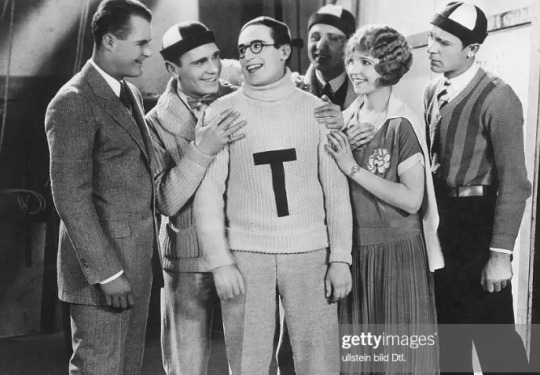
Photography was generally quite accessible by the 1920s, though, and you can find a lot of authentic photos of people from all walks of life, out in the wild wearing all sorts of clothes.
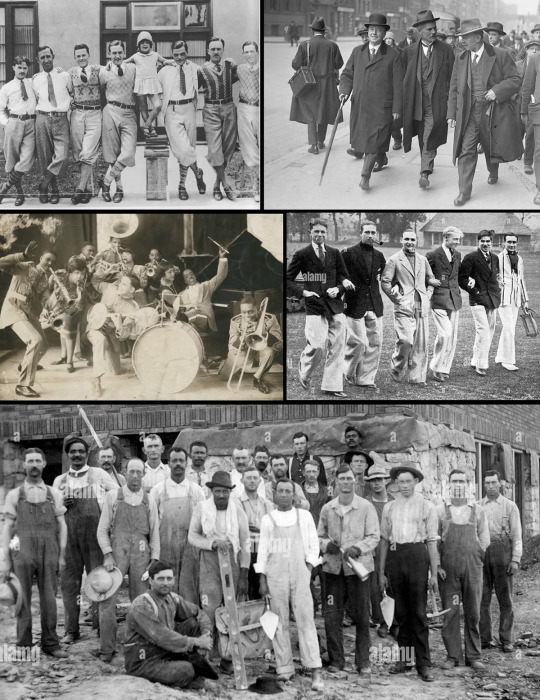
This is by no means the limit to the resources available, but hopefully it'll provide some leaping-off points for designing looks for your characters!
3K notes
·
View notes
Note
This is kind of random, but would it have been a struggle for a big busted women to wear fashionable silhouettes in the medieval era? I’ve heard some costume historians discuss that there were forms of bust support, but most of what I’ve seen pre-1500s seems like it would have been a nightmare for any ancestor with a similar bodytype to wear. Am I just from a line of women doomed to horrible back pain? (On the flip side of the situation, I’ve found corsets and stays to be rather comfortable, so that’s not a problem)
As a fellow big boob haver, I have good news for you! There were pretty good Medieval bust supporting garments and I have tested one of them.
With sturdy fabric, tailoring and lacing you can create pretty good bust support. Lacing was popularized first in 12th century in form of bliaut, and in 14th century tailoring became standard for everyday garments. I don't know how well bliaut supported the bust, but since it doesn't fit super snugly, I assume it doesn't distribute the weight of the boobs as well as tailored supporting garments and therefore isn't as supportive. I'm also not actually sure if there was proper bust supporting garments before that, I haven't looked into it. I know Romans bound their breasts with cloth wrapped around the chest, so maybe that technique continued (at least for those who especially needed it) till lacing and tailoring became a thing. For more about how supporting garments developed in Europe through history, I have a post about development of lacing, which coincides pretty well with that history from 12th century forward.
Personally I have experience with Medieval Bathhouse dress, which was used in the Germanic Central-European area roughly in 14th to 16th century. It's called the Bathhouse dress because most depictions of it are from bathhouse settings, but there's depiction also in bed chambers and other contexts, so I think it's pretty safe to assume it was used more generally as an undergarment. It often had separate cups for the boobs (see the only extant garment left of it, the so called "Lengberg Castle Bra"), but not always. Unlike most other undergarments at the time, it was sort of a shift (the lowest layer) and a supporting garment combined into one.
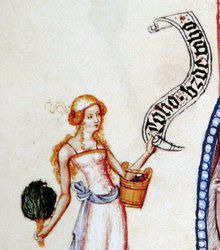

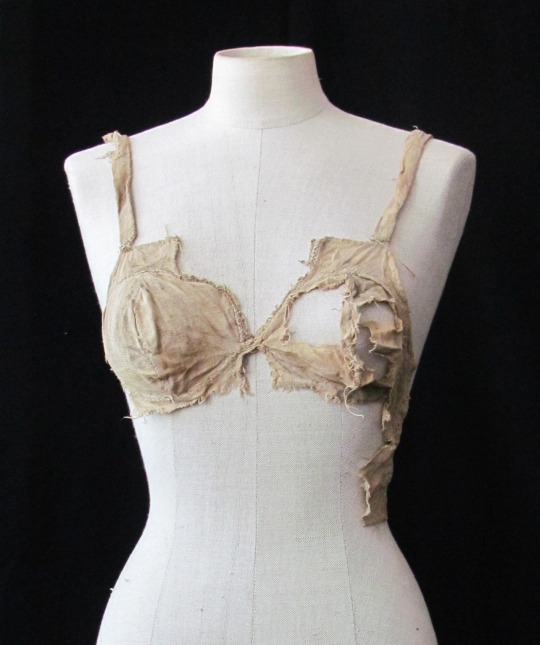
I sewed my own recreation of it (with some alterations because I made it for my everyday use, not as a historical recreation) and did a post about my results, where I go deeper into the history of the garment too. I didn't construct it very well and I did an error in the design of the back, which cause the strain of the shoulder straps to focus too much on very specific spots in the back panel, which eventually made the fabric there break too many times. (There were some other smaller design flaws too, like the waistline is lower than my natural waist so it rose and wrinkled annoyingly.) I did use it daily (except when I washed it) for a fairly long time though and it was super comfortable and helped a lot with back pain (and shoulder pain caused by use of modern bras). I hate that I've had to go back to modern bras because I haven't had the time to remake it yet. (I'll probably make a follow up post once I get around to it, where I go through the issues of the first version and how I addressed them in the next attempt.) Well fitted and shaped bodice which is then laced does surprisingly much even without any additional reinforcements.
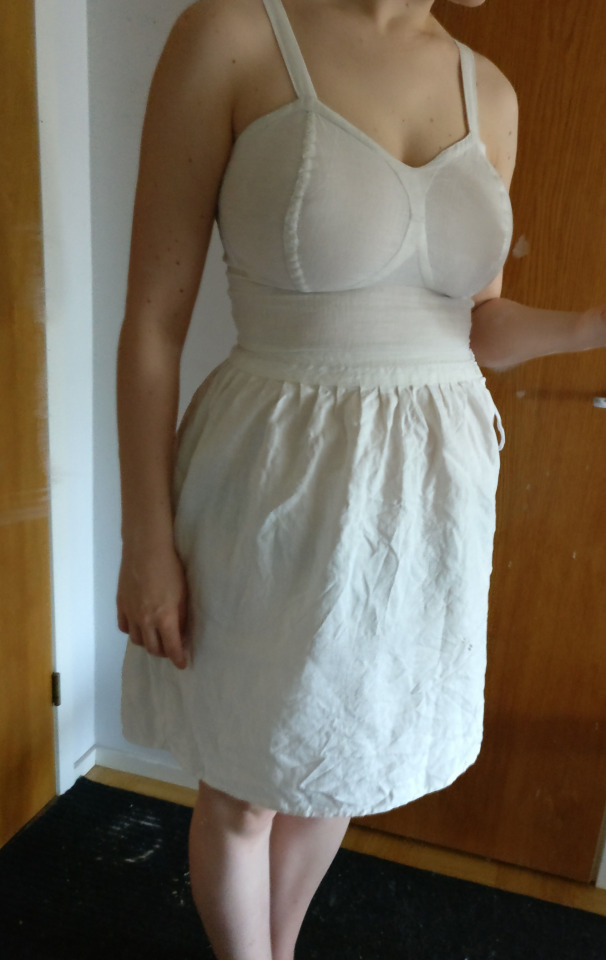

I haven't made a Medieval kirtle (though I will some day), but it was the more widely used Medieval supporting garment, which eventually replaced Bathhouse dress in the area where that was used. Kirtle is worn over a shift, but it broadly works similarly. Kirtles could be front, side or back laced depending on the time period and how the Kirtle was constructed. Multiple layers of kirtles could be used and looser overgarments (like houppelande) were often used on top of it. Kirtle was used by everyone, including men, but for those who didn't need bust support, it's purpose was mainly to create the fashionable silhouette. Here's three depictions of kirtles from 15th century. First unlaced, but has lacing on the front, second close up of the side lacing and third shows nicely how both front and side/backlacing shaped the bust.

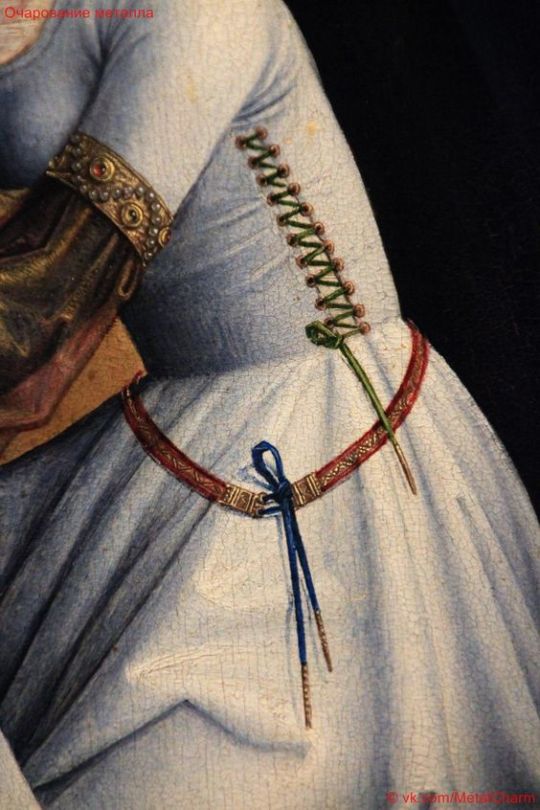
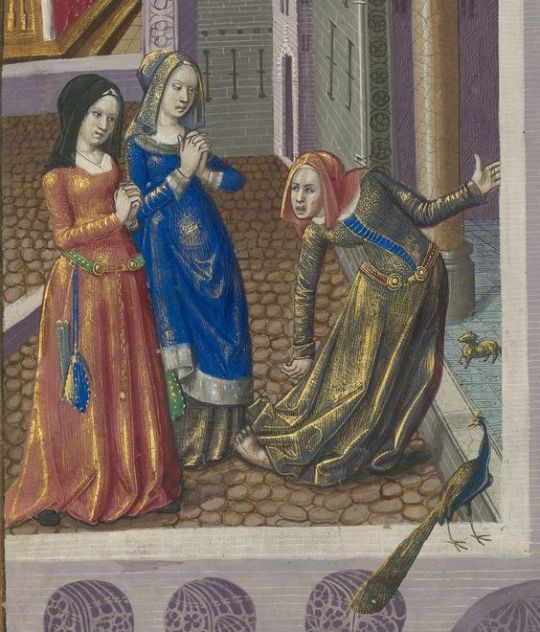
Morgan Donner is a costumer, who focuses a lot on Medieval costuming and has a big bust, so while I haven't personally tested the supportiveness of kirtle, she certainly has. The kirtle bodice part needs to be patterned to accommodate the breasts by giving it round shapes and the kirtle needs to be a little too small so there's room to lace it to fit well. Lining also helps to reinforce the fabric and make it more firm and supportive. Here's Morgan's pattern from the tutorial in her website and how the kirtle eventually fits for her. (Also look at the handsome boy in his handsome matching outfit.)
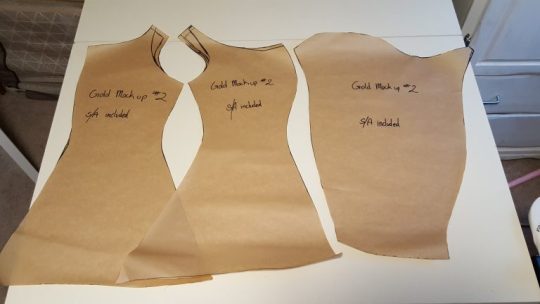
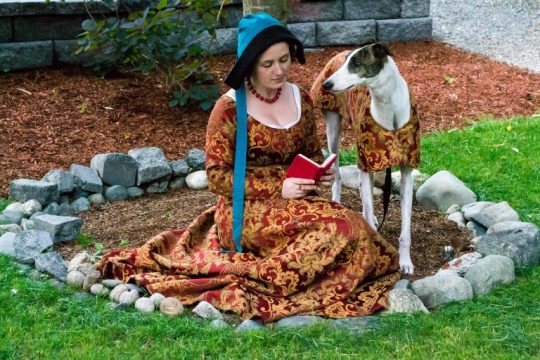
She also has a video relating to the same kirtle project, where she explains her method to pattern a kirtle specifically so it's supportive for big bust.
In 16th century more stiffness was added to kirtles, first with very stiff lining and then with boning, but that doesn't necessarily add to the bust support, rather it just allows the kirtle to shape the bust and the body in general more and better support a heavy skirt. Firm fabric secured snugly with lacing is already very good at distributing the weight of the boobs to the whole torso.
In conclusion, at least since 14th century people with our body type were not doomed to eternal back pain and even before that some ways to help with it were probably used.
#historical fashion#fashion history#dress history#history#historical costuming#historical sewing#sewing#crafts#costuming#fashion#medieval fashion
232 notes
·
View notes
Text
Fashion history resources?
researching fashion for the various time periods has been driving me a little crazy, particularly because when you search up historical fashion, the results overwhelmingly trend towards upper class women (usually aristocracy), then upper class/aristocratic men, then middle class men/women, with little representation of working class women and even less for working class men. (This obviously depends on time period and country; currently, I'm scrounging around for references for servants in 1660s France. Non-European fashion is even harder to research).
So, I figured it could be good to start a chain of resources on fashion history! Here's two that I've been using heavily in researching my current WIP:
Nicole Kipar's Restoration Costume Comes to Life
This truly lovely website which details costumes of the Restoration (1660s England, mostly), and has a gallery collection of paintings of working class people with annotations on what they're wearing, the time period, and their specific social role (i.e., poor peasant, affluent peasant, market trader). It's designed for costume makers, but it's also useful for artists or writers. There are five parts: working class men and women, women of the gentry and aristocracy, men of the gentry and aristocracy, accessories, and a costume focus.
Fashion History Timeline
It is what the name suggests: open source fashion history timeline from prehistory to (afaik) 19th century. I haven't explored much beyond 1660s yet, and generally does seem to focus on fashion of the upper classes, but it's already been so useful.
If anyone has any websites/books/other resources to add, please do!
956 notes
·
View notes
Text
[ 08 ] GONNA SHIT MYSELF WTAF
status : unedited, written 01/04/24 ☆ word count : 0.8k

Y/N’S POV ⟡ COSTUME ROOM
every time you willed the universe to give you a break it found a way to somehow make matters worse.
it all started with your conversation with hu tao earlier that morning. the incident with albedo made sure that your nerves were on edge pretty much the entire day but what your friend said made you want to move across the globe and never return.
maybe if she hadn’t mentioned the possibility of running into a certain grey haired man maybe none of this would’ve happened in the first place.
you were silently freaking out at every random interaction you had. despite knowing the fact that you had no overlapping classes with cyno as he was a computer science major while you were studying fashion design; meaning you’d be studying on opposite sides of the campus.
honestly that made you even more nervous because alongside your history of “short lived crushes”, you also had a track record of bad luck. not one that could compare to a certain blonde engineering major but still bad nonetheless.
play practice was going half decently well. you had managed to escape interacting with others in the theater as you were mostly confined to the space of the costume room along side a couple other students.
it felt like you could finally breathe for the first time that day since you weren’t constantly trying to hide your presence.
“hey y/n i’m going to step out for a bit to measure some of the actors in the theater!” hu tao said, standing in the doorway. “you’ll be okay here by yourself right?”
you looked up from the racks you were sorting through.
“yea no worries. just looking through these racks from the previous years for anything we can use” you replied before turning your focus back to the costumes.
“thanks, we’ll make send anyone down if they have any questions!!” your bestfriend responded before turning to walk out.
you let out a hum in response fully diverting your attention.
it was peaceful being alone in the costume room. it was kind of dusty and cluttered but it was also filled to the brim with clothes, accessories, and fabric. the fashion design major in you was sobbing from the amount of things you could mess around with.
you were snapped out of your little headspace when you detected a new presence in the room.
curious, you peeked out from behind the racks. that, however, was your first mistake.
“um.. are you y/n?” a slightly familiar voice questioned.
you were trying to connect the dots as to why this person’s voice sounded familiar and it finally hit you as your eyes landed on the one person you didn’t want to interact with.
“yea!! how’d you know?” you said in a overly friendly tone in an attempt to cool your nerves.
cautiously, you stepped out from behind the racks to face the guy you had been avoiding all day.
“i was sent down here by hu tao,” cyno explained. “i’m cyno.”
“ohh i guess that makes sense, it’s nice to meet you! i’m on costume design for the play, just thought i should mention,” you paused to think, head tilted to the side in confusion before you continued. “did you need something from me?”
cyno shook his head.
“no, not really. just wanted to ask you a question if that’s okay”
“if it’s about costumes or the play you know i’m more than happy to answer them for—“
“do you happen to be friends with albedo?” cyno interrupted.
your sweat dropped and your nervous system started to go haywire. the urge to book it out the room and flee was overriding all of your other thoughts.
“oh haha.. uh albedo huh?” you said nervously. that was your second mistake.
“so you do???” cyno narrowed his eyes at you and took a step forward as you took a step back.
“yes…?” you looked around hoping that anyone come to your rescue and interrupt the unwanted confrontation.
when cyno took a step forward, you took a step back to maintain a safe distance away from the intimidating, yet extremely attractive, male.
this cycle continued.
that was until you realized you had effectively cornered yourself against a wall next to one of the costume racks. your third mistake.
you mentally facepalmed at your lack of spacial awareness.
“then does that mean you’re the one he was talking about?” he took another step closer.
“ahaha i have NO CLUE what you’re talking about cyno!!” you said trying to laugh off the sudden tension.
you were starting to panic. not only was this costume room stuffy and triggering your asthma but you also found it particularly hard to breathe when a really attractive guy was practically interrogating you.
and that’s how you found yourself in this awkward predicament that made you wish you had a twin that swallowed you in the womb.
‘i should just quit life huh’
“y/nnnn do you know where the measuring tape is?? it wasn’t in the theater and i can’t find— WHAT THE FUCK????”


prev ︴masterlist ︴next
AUTHOR’S NOTES : note that the costume room is going to play a ( somewhat big ) part of the story btww (*´▽`*) this was also kinda a nightmare to write bc i was fist fighting w/ the dialogue and awkward word repetition way too much😕
cyno is so silly.. ik this is from y/n’s pov so it’s hard to tell bc of his bluntness, but he’s actually genuinely curious abt the whole admirer thing. which i find hilarious bc he comes off as freakishly intimidating while confronting ppl😭 it’s bc he has somewhat of an rbf and is completely unaware of it૮꒰ ˶• ༝ •˶꒱ა ( hence the ‘lack of expression’ i mentioned in a previous chapter )
— TAGLIST : @ioveaether @otomegame-oneshots @ashyiiy @mafuyuslover @yuminako @waengyknow @sharkdays @tikitsune @jihoonotes @gallantys @keiiqq @mochibaby123 @lambcandle @ell1e2010
#{ k4zushi writings ໒꒰՞ ܸ. .ܸ՞꒱ა }#cyno#cyno x reader#genshin cyno#genshin#genshin impact#genshin fluff#genshin angst#genshin smau#genshin x reader#genshin fanfic#genshin x you#cyno fluff
121 notes
·
View notes
Text

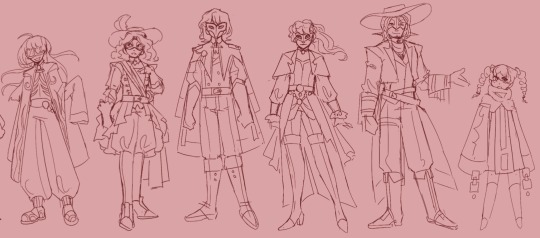
Sketches of all my redone designs for my Phantom Thieves from my AU, Icarus! Lots of info down below on the cut, so if you want to know more about the details and inspiration, feel free to keep reading!
This includes Akechi’s design for his Princely/Robin Hood attire, BEFORE his Icarus attire you might have seen from my other posts! Check out the Icarus AU tag for more info! Icarus has a main focus on Akechi and his relationship to the thieves, but the AU is actually an entire rewrite with new designs, 3rd semester and epilogue/strikers/tactica stories, hence Zenkichi and Sophia’s inclusion.
Read below for individual info:
I decided to include more motifs towards their persona’s and general vibes; and also just my own personal touches haha.
AKIRA - Not much has changed, I really like his design overall. I raised his boots to be like Arsene’s and changed his neck area.
MORGANA - I hate the OG pill shaped head, his new design is based heavily on the shape of Palico’s from Monster Hunter. Added a little more nod to Zorro/His persona motifs and also just made him cuter! Little hamburger headed cat.
RYUJI - I made him a little bulkier and gave some more weight to his outfit overall. I gave him heavier boots and a slightly buffer build to relate back more to his sporty style.
ANN - honestly was never too big on her latex outfit, I wanted to call back to a personal favorite female lead; Christine Daae, and used one of the versions of her Don Juan costume as inspiration. I remember seeing Phantom live and in many stage versions of her character, the Don Juan scene was a pure moment of female control, and she was truly working the Phantom and controlling every movement on the stage. Her presence is commanding, and I thought it was a very fitting tribute to Ann’s character as feminine strength. (I’m absolutely not referring to the movie iteration of Daae btw.)
YUSUKE - I referred to some historical art and legend of Goemon to add more elements of design to his outfit. When I color them, I want to add some really strong pops of color to his clothing to really drive the aesthetics and artistry home.
MAKOTO - Another totally redid outfit, I opted to give her a design which relates back to Popess Joan, and also Anat. I gave her a clawed hand on her right side and an uncovered hand on her left as both a nod to Anat’s hand raised in iconography of her from art history, but also to show the duality of Anat’s title as both a goddess of war, and of love. It also relates to the mythology of Joan and her nature as both a leader and a martyr. I changed her mask to a Venetian Commedia mask as well.
FUTABA - ok. I’ll be honest. I never liked her skin-tight outfit, it just doesn’t match her personality at all. Also, the high tech Egyptian feel never really sold me. I totally understand the tomb thing, but I truthfully think a dungeon/palace which was more like… tech/nerd themed would have been much more “futaba” the inspiration for this new outfit relates back to her persona, the Necromomicon, as well as her nerdy personality, and her affiliation as Alibaba (Ali Baba.) I wanted to go more lovecraftian, long sleeves and patterning designed to look more like lovecraftian tendrils, and big baggy pants and her classic shoes to match. The patterning on her undershirt will resemble a rib cage, both as a reference to her deathly “tomb” iconography, but also to Lovecraftian and Necronomicon lore. I think she matches the description of a nerdy, techie DND dungeon master more than the initial outfit, so that’s the route I took personally.
HARU - relating back to some fashions from 17th c France, where Milady’s story (the three musketeers) takes place, I kept her design relatively similar. I just gave her a little more iconography relating to the three musketeers and that general timeframe.
AKECHI - in his pre-Icarus outfit, I’ve given him a princely sort of outfit befitting of his two faced nature, and edited it to relate to Robin Hood a little more. I tried to keep it sleek and just generally very concealing and layered.
SUMIRE - i gave her some iconography relating back to one of her personas, who is an inference to Freya. I also included some more nods to classic Cinderella, with fantasy gown elements. Overall, relatively similar.
ZENKICHI - again, relatively similar, I really like his outfit. I just opened up the face some to show more personality and spiced up the outfit generally to keep it matching. honestly, les mis/Valjean was a hard one, but I also think his character could be heavily related back to Edmond Dante (Monte Cristo.) so I gave some nods to that as well.
SOPHIA - I turned her into a FINGIE!!!! I made her whole dress as a nod to her persona/to pandora’s tiles around her/the pillars. I wanted to make her small and almost unnatural since she’s an AI, and I thought having a little guy on the team would add some more variation.
#persona 5 icarus au#persona 5#p5#persona 5 au#persona 5 royal#akira kurusu#ren amamiya#p5 Mona#p5 morgana#ryuji sakamoto#ann takamaki#yusuke kitagawa#makoto nijima#futaba sakura#haru okumura#akechi goro#goro akechi#zenkichi hasegawa#p5 Sophia#sumire yoshizawa#persona 5 strikers#persona#akechi#shin megami tensei#art#digital art#akeshu#shuake#gavaladraws
220 notes
·
View notes
Note
Something I can't help but notice - and I'm wondering if your American Girl posts are making me think more about this - is that we tend to see fashion/period clothing only in terms of the rich or later on middle class. Other than the Appalachian flour sack dresses my grandmother grew up with, I can't really think of a fashion trend I associate with poorer people. Can you shed some light on the subject?
it's survivor bias- only the really fancy elaborate fashion of the very wealthy really gets preserved. Fashion historians tend to focus on the extraordinary and don't pay as much attention to the clothes of the working class and every day. Unless it becomes something like blue jeans in which case the fact that most early examples were worn to pieces and thrown away just makes surviving examples incredibly fucking valuable.
It's something you see in plus size fashion, too.
Museum curators would only save clothes that would fit a standard mannequin, so a lot of plus-size fashion history got lost because of that.
"Ethnic" fashion for as amazing and diverse as it is, is extremely difficult to research because but Western museums don't save it like they do everything else.
508 notes
·
View notes
Text
Once again, I am doing a series of my behind-the-scenes thoughts for The Golds while I do light edits for formatting, typos, and continuity. Here’s Chapter 1!
DO NOT read these commentaries until you have finishes reading the entirety of The Golds! These commentaries have many spoilers for future chapters.

First I’m gonna talk about why I decided to write this fic in the first place, because it wasn’t part of my original roadmap for the series. After I finished writing Daemon’s Handbook, my plan was to write an epic longfic with POVs from all the Targkids that encompassed a multi-year timespan a la the ASOIAF books…and then I realized if I did that, I had high odds of burning out halfway through 💀.
I’ve discovered that I do better at writing fic if I have an ending an mind when I start writing it, and the story needs to be something I can finish writing in several months so I don’t lose steam or get distracted/go on hiatus too long. That meant I needed to focus on a specific story with 1-2 protagonists/narrators that had its own complete story arc within the series’ larger arc.
When I finished writing the Handbook, I read a lot of books during my break. Several of those books were about fashion history, and one was the official GOT costumes book. I got really obsessed with fashion in the HOTD world, and I temporarily thought about writing a Rhaena POV fic because in my verse, she’s really into fashion and I wanted to put my newfound amateur knowledge to use 😅. But as I brainstormed what her story would look like, I realized it was super adjacent to Jace’s story because Rhaena is her lady-in-waiting, and eventually I shifted over to a Jace-centric story.
While I was brainstorming the Rhaena fic, I thought of a pregnancy subplot where Rhaena has to create Jace’s pregnancy wardrobe, and that pregnancy plot ultimately became the central story in The Golds. I was originally going to make Jace the sole narrator as she deals with the pregnancy, but I realized Aegon would have some really entertaining thoughts so I made it dual POV. This is when I started thinking about the Bridgerton approach, where each Targkid gets to be the star/costar of their own story in roughly chronological order.
The title “The Golds” is a reference to the canonical Greens and Blacks. There’s a theme throughout the story of Jace and Aegon accumulating popularity and soft power at court and among the smallfolk. This growing faction will unofficially be called the Golds because Jace and Aegon are strongly affiliated with that color, due to Sunfyre’s scales, Jace’s preference for gold, and all the symbolism that gold entails.
Most chapter titles are lyrics from the in-universe lullaby “The Song of the Seven.” Since the fic is about pregnancy, childbirth, and parenthood, I thought a reference to this lullaby was appropriate. My original outline had 7 chapters for the fic so I was going to title each chapter after the first line of each stanza in the lullaby. As I wrote the fic and realized it was going to be more chapters, I had to get creative. For Chapter 1, I picked the Maiden lyrics because the Maiden is associated with innocence and young women. Aside from this chapter including the wedding night (and thus Jace’s last night as a maiden), this is also the beginning of Jace’s character and emotional journey, during which she becomes less innocent/naive and, as you know, encounters a lot of darkness in the real world.
Ok now for the actual chapter commentary lol
I started showing during the Handbook that Jace is a responsible, dutiful “eldest sibling syndrome” kind of person, and I wanted to really highlight that in this fic. In the beginning of this story, Jace is the neurotic workaholic while Aegon is hedonistic and urges her to relax. Throughout the story, Jace does learn to relax and delegate better, but Aegon also starts picking up responsibilities along the way. By the end, my goal was for them to meet in the middle, where Jace learns that she has to take care of herself if she wants to take care of others, and Aegon learns that he needs to put in some work in order to secure the things he really wants in life.
There’s also a theme of private vs. public. Jace starts as having a very public life (she’s the heir to the throne, her life is on display at court) while being very private about things like her body and personal wants. In contrast, Aegon is very public about his body (the casual nudity is canon, don’t blame me) and personal wants (“I love my wife and everyone must know it”), but he wishes he could have a private life (be his own person and do what he wants, rather than be the prince and politician his family wants). Again, they kind of grow to meet in the middle by the end. Jace learns to be more selfish about her desires and fight for them (she also becomes more comfortable with her body around Aegon, although the self-consciousness never entirely goes away). Aegon learns to put aside his hangups about “I don’t want to be a player in the game” and steps into the arena so he can ultimately achieve what he wants, which is to protect Jace and their child.
We see the beginnings of Aegon’s powers of observation this chapter. He notices the Bracken/Blackwood exchange (these are the same lovers that Daemon spies in the tunnels in Chapter 9 of the Handbook) and deduces a likely explanation. This trait was inspired by a TGC quote about how Aegon is very observant and knows people’s weaknesses. I loved this idea that Aegon observes a lot of what’s happening around him, but canonically he’s too drunk and apathetic to do much about it. Here, Aegon is not an alcoholic and he’s a lot more grounded, so he actively registers a lot more details.
I mention in Chapter 2 that Daemon is part of the reason Aegon doesn’t drink so much, but that’s definitely not the whole story. Aegon seems very driven by the pursuit of dopamine, things that give him pleasure. In canon, he achieves this through whoring and alcoholism. Here, he has Jace, who has always fulfilled many of his emotional needs and now his physical needs. His life is a lot happier, so there’s no need for him to drink himself into a stupor. He did still have a youthful period of debauchery, but it’s not an outrageous amount of debauchery for a spoiled prince—although still in an upper percentile.
Aegon remains impressively chaste during the Stepstones because he realizes his youthful debauchery was a big reason Rhaenyra disapproved of him. And by the time he leaves for the Stepstones, he’s realized (thanks in part to their forced separation, thanks in part to Jace being the prettiest girl he can ever imagine existing) that no other woman is ever going to compare to Jace, so why bother? (He definitely had a locket or something with Jace’s mini portrait and lock of hair lol)
Aegon’s attitude toward dancing (he’s good at it but he hates the formality) is similar to his overall attitude toward court life and politics. He can do it if he wants, but he just doesn’t want to—unless it makes Jace happy.
Confession: the Tyroshi subplot wasn’t supposed to happen the way it did. I’ll explain more in future chapters, but for now, I’ll just say Floris and Sara weren’t always intended to die. But they did die in the final draft, and in hindsight I’m glad I included the Baratheon scene this chapter. Originally the scene was supposed to showcase Jace’s politicking and diplomacy, as well as lead up to her eventually picking Floris as a lady-in-waiting. Now it has extra meaning because it shows how sweet Floris was, how she fit in with her sisters, and how her mother doted on her 🥺.
I actually kind of like Maris, she’s funny in a mean girl way 😂. But she canonically has a tendency to run her mouth and say nasty things. Here, I think she feels jealous that Cassandra is getting so much attention from potential suitors, and that contributes to her rudeness. Jace could have publicly shamed Maris for being so rude to a Targaryen bride at her own wedding, but she decided to be sneakier about it and not cause a scene. Jace wants to maintain a good relationship with the Baratheons while making it clear what Maris said is unacceptable, so she extends the private tea invite to the other Baratheon women while deliberately omitting Maris from the offer. Now Lady Elenda feels honored by the invite and relieved to not have disfavor, and she’ll probably give Maris a terrible scolding in private.
The bedding tradition seems awful and potentially traumatic, especially for the bride (but that’s ASOIAF for you!). I can’t remember what’s canon or fanon, but I went with the interpretation that the bride and groom are supposed to be stripped naked or close to it. I feel like the royal family ought to be exempt from it (in a privileged “nobody else is allowed to behold our naked bodies” kind of way), but I know Alysanne made a point of having the bedding ceremony so nobody could question her marriage was consummated. The ceremony also seems horribly wasteful because all that expensive material and labor that went into the wedding clothes is just trashed, but I guess it’s a status flex. Only the super-rich can afford to deliberately destroy all those resources after one use.
I wish I wrote more scenes where Jace and Aemond hang out 😭. They have a lot of similarities: dutiful, studious, responsible for their siblings. I imagine their relationship being super chill. Then again, they’re very proper so they probably have hangups about spending alone time with someone of the opposite gender for extended periods of time 🙃. Anyway, their relationship is much less antagonistic than in canon. Fem!Jace thinks bullying is wrong and tones down Aegon’s mean streak, while Aemond has a chivalrous and gentlemanly attitude toward women (contrast with book!Aemond, who seems pretty misogynistic). Since a lot of the friction from canon is removed, they get along much better, and this Aemond is more comfortable with the idea of fem!Jace being queen one day because they start from a better place, and he’s her good-brother.
You can see my newfound fashion history geekery showing itself during the scene where Jace gets ready for bed. (Also, take note of how meticulous Jace is. It highlights her general cautiousness, and it serves as a contrast for Chapter 3). I try not to get too flowery with description, but I decided it was relevant to highlight key fashion choices like her wedding dress because it is an aspect of Jace’s influence at court, and she is concerned about appearances. I incorporated a lot of design aspects from GOT, which are much less medieval than the HOTD gowns. I had this idea that the older generation (Alicent and Rhaenyra) stick more to traditional cuts and designs, while Jace and the other girls are starting a new fashion trend akin to what we see in GOT, where styles are more flattering and multicultural.
Jace’s wedding dress is strongly influenced by Margaery’s Purple Wedding dress. The backless part makes it rather daring, and it’s part of Jace and Rhaena’s goal to depict Jace as a leader among the younger ladies at court since matrons are far less likely to wear something so revealing. Also, in GOT, Daenerys’s dresses tend to be much more revealing than anyone else’s, so I deduced that the fashion culture in Essos is overall more daring than in Westeros. Rhaena grew up in Pentos, so I decided she brings that influence into Jace’s wardrobe, which then spreads through court. Jace’s jewelry (heirlooms owned by Valaena Velaryon, mother of the Conqueror and his sisters) is also a statement to highlight that she was born a Velaryon but now she’s a true Targaryen in name.
Jace’s lingerie is definitely Rhaena’s (and Baela’s) influence. Otherwise she would have zero clue what’s fashionable in Lys. 😳
Jace deciding to work on her wedding night is very in character for her. And Aegon making her stop to enjoy herself is also very in character for him. Definitely a recurring pattern for these two.
Like any scene I write, I try to make sure the smut has a purpose in the story. I don’t usually write PWP but I think smut scenes are an excellent way to demonstrate dynamics and emotional connections between characters, so that’s how I typically use them. Here, we see Aegon is devoted to Jace: makes her feel comfortable, ample foreplay, even cracks a few jokes because their relationship is familiar enough for that sort of thing. He literally “lets her hair down” so she can shed her usual inhibitions.
True to character, Jace overthinks the process. She knows the theory of how it works (Rhaenyra would ensure her daughters are informed of the mechanics, and Jace has been living with Baela for three years). She also knows Aegon enjoyed his time on the Street of Silk and she desperately wants to meet his expectations. She doesn’t realize that she could do literally anything (or nothing) and Aegon would still think she’s perfect.
Since Aegon hasn’t had sex in three years, he’s trying very hard not to finish too early 😅. It’s OK though, Jace has no idea how long a guy is supposed to last and they have the whole night to make up for it 😂.
In the Handbook, I hint at Aegon’s artistic tendencies when he doodles in his letters. Here, I expand upon that so he’s sort of a Renaissance man: he sings, he plays lute, he dances, he draws, etc etc. All the skills he enjoys are skills not conducive for a politician/king. In this verse, Jace encourages him to sing and draw, so he pursues it further than he would’ve in canon.
I like to think of the morning-after smut scene as when Cheeseball is conceived 😂. It’s when Aegon dirty talks about making heirs for the throne, and Jace thinks about how much she would like to have children with Aegon. It just makes sense lol.
GRRM makes his female characters give birth way too young. Some people argue it’s historically accurate, but it’s really not. Other than Margaret Beaufort (who gave birth at 13 and never had any other children, probably due to complications), royal and noble women generally married in their late teens and early twenties. But this is the world and culture GRRM created, so I’m trying to work with it. I still headcanon that in normal peacetime, highborns try to wait until bride and groom are at least 16 to marry because they are aware that giving birth too young is dangerous. It’s during wartime or when politics require an earlier consummation that we see things like Sansa marrying at 13 💀. So I made Jace realize, after she’s had time to stew, that being forced to wait three years was best. (Especially since she IMMEDIATELY gets pregnant.)
I had to research whether people with a broken nose (or recovering from rhinoplasty surgery, which apparently has similar side effects—the more you know!) could have sex. Apparently one of the concerns is causing blood vessels around the nose to expand/contract/whatnot, and arousal impacts blood flow so that’s why Orwyle bans any nookie 😔. No wonder Aegon bribes Alyssa to wake Daemon early lol.
A side effect of broken noses is bruising around the face and black eyes, so Jace looks like she got hit very badly. The ensuing gossip about how she got injured ties into the recurring themes of a) Jace’s concern with appearances and b) that courtiers can and will gossip about anything, and the more salacious the better.
Jace is pretty peeved that Luce was so reckless re: the tunnel incident, and probably upset that it inadvertently led to her broken nose. But as soon as Luce needs help, Jace stops caring about her injuries 😭. Another recurring part of Jace’s personality: she’ll do almost anything to help her loved ones but she’s much harder on herself. (Note Luce’s little question, “What do I do now?” which is a question she always asked Jace when she was in trouble as a kid.)
Aegon is closer to Aemond than in canon, since a) they went to the Stepstones together and b) Aegon had far fewer options for male companionship in this genderbent world so he had to lean on Aemond a lot more. The brothers aren’t the kind to have heart-to-hearts, but Aegon knows Aemond well enough to know that Aemond is really into Luce and is probably going to try to marry her.
With Larys dead, there isn’t a very good option for master of whisperers. The council keeps trying to fill it but the candidates never last for long. I like to joke that they’re holding the seat open for when Joff is old enough, but finding a good spymaster seems pretty difficult. Daemon would probably be good at it but he’s already flamed out of several council positions, and he would hate working with Otto.
A little more fashion history! A surcote is that quintessential medieval gown for women, which I decided is very traditional in Westeros. This is Jace’s first day at her new job, so she wants to dress extra conservatively. Color is a big deal in this world of Black versus Green, so she deliberately picks very neutral and inoffensive colors. She also styles her hair and wears gold jewelry from Aegon to emphasize her new marriage, which shows she’s a mature woman and is forging harmonious bonds with her husband across the Black/Green divide.
In canon, Corlys resigns his position as master of ships around Episode 2. Tyland is canonically master of ships during this time, but I made an error in the Handbook and turned him into the master of coin. So I decided to just force Lyman Beesbury into retirement, and this can serve as an in-universe explanation for the change in roles: Viserys (or somebody else) wanted Corlys to have his position back, so they reshuffled the council a bit.
Aaaaand Jace officially has a “first day at work” horror history. Vomited, fainted, and cried in quick succession. And for someone who values privacy regarding her body, this was an awfully public way for her to find out about her pregnancy (and have it announced) 🥲.
#my writing#meta#fanfic meta#hotd meta#house of the dragon meta#Aegon II Targaryen#female jacaerys velaryon#the golds
26 notes
·
View notes
Note
Is there a difference between togas for guys and togas for girls? :]
Absolutely. First, @creative-chaos-apparently is right that generally, women didn't wear togas. Let me tell you about some of what was worn.
I'll try not to ramble on too much... XD
Here we go:
In Rome, what you wore was a sure sign of your status.
Men all wore tunics. Equestrian men had a tunic with narrow stripes and broad stripes were on the tunics of men of the senatorial class. Men also wore a tunic with a pallium, which is sort of like a cloak. It was a long rectangular bit of cloth.
Freedman and slaves also wore tunics that were usually pulled up with their belts for easier movement.
(Not my art, but came up under a search for copyright free images.)
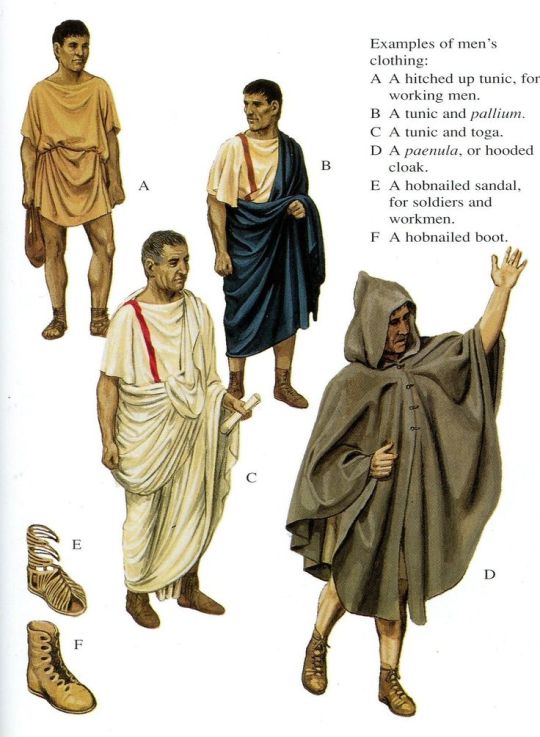
The toga was only allowed to be worn by male citizens. Think of them as special occasion clothes/ceremonial clothes, almost. There were a lot of different types of togas I won't get into here, but suffice it to say they had many styles.
Boys had their own type of toga to wear if they were freeborn, but they were expensive so mostly only the upper class boys had them.
Women very early in Roman history wore togas, but very quickly they became something that only men and female prostitutes wore.
Women also could wear tunics. Other than a tunic, married women who were citizens wore a palla (woolen cloak) overtop a stola, a long dress.
(Again, I do not own this artwork but supposedly it is public domain.)
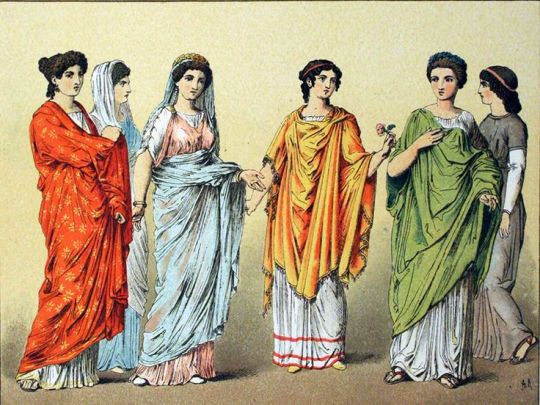
Young girls wore long tunics and in public had another one overtop of it.
Now some sources say that a freeborn girl could wear a toga praetexta until marriage, but that is a contested topic.
A woman in public would have covered her hair, usually with her palla.
Sources:
I really just knew this stuff because of my Classical Humanities major, but if you're looking for books on the topic, here are some classic titles:
Costumes of the Greeks and Romans by Thomas Hope
Ancient Greek, Roman and Byzantine Costume and Decoration by Mary Galway Houston
The World of Roman Costume edited by Judith Lynn Sebesta and Larissa Bonfante
And this one is available for downloading:
I certainly didn't focus on Roman clothing, so this is not my specific area of expertise. I do think being a fashion historian is fascinating.
I may have to post about jewelry in ancient Rome or Greece or Egypt some time...
17 notes
·
View notes
Text
Hello! This is a sort of mini article about lolita fashion! (More of an introduction article) Enjoy!
Lolita fashion-
♡ What is lolita fashion? ♡
Lolita fashion is a subculture which originated in Japan in the early 90s, and gained popularity throughout the mid 90s and early 2000s. The fashion is inspired by victorian clothing and rococo period and is a cute, elegant and modest style.a typical lolita outfit consists of a blouse, a dress or a skirt, a petticoat, long stockings and some headresses such as hats, bows, rectangles and many more. The lolita subculture is divided into 3 main styles- gothic lolita, classic lolita, and sweet/pastel lolita. There are a lot of in-between styles such as hime (princess) lolita, punk lolita, sailor lolita, guro(horror) lolita and many more. A common misconception about lolita fashion is mixing it up with cosplay, which is wrong. lolita is not cosplay, it is a lifestyle and a form of self expression through clothes, while cosplay is a form of roleplay, pretending to be someone else using costumes. another misconception about lolita, is thinking that it has anything to do with the famous novel written by vladimir nabokov lolita, which contains depictions of sexual abuse and pedophilia. The fashion itself is very modest and doesn't focus on sexuality. The meaning and reason for dressing lolita is different for each person. Some dress this way because they find it pretty, and some want to celebrate their femininity in a different and more modest way, rather than enhancing their feminine features. Some wear it as a way to rebel against society's pressure on grown people to act and dress a certain way.
♡ history & origin ♡
Although lolita became an established subculture only in the early 90s, its origins date back to the late 1970s. With kawaii culture taking its first steps, and the admiration of French culture being common among the youth, a new type of female street fashion was born, which is called otome (maiden) kei. It is a casual, romantic hyper feminine style, inspired by the European fashion and femininity of the 1960s. As a result, a lot of fashion brands such as milk, pretty (now known as angelic pretty) and pink house adopted this new look, and the style became very popular in Harajuku district in tokyo. During the 80s, the popular magazine olive influenced fashion by featuring those brands, and promoting a "french lifestyle", which paved the way for future lolita brands. The romantic french look of the 80s was a start, and a little later lolita was born! street fashion magazines such as kera and fruits started featuring lolita fashion in their issues, and the fashion became more popular. The 90s were also when gothic lolita made its first appearance, which was created by the visual kei guitarist mana sama. He created a link between Visual Kei aesthetic and a dark Victorian twist on lolita. He also opened his own brand, moi meme moitie which was a refreshing alternative to the classic lolita brands, and has influenced lolita to this day. At the time, lolita fashion became more defined and, by the noughties decade it was at its peak. Kera published the famous spin off magazine, gothic & lolita bible, which featured diy and makeup tutorials, interviews with designers and musicians, street photographs, new collections and many more. By that time, pretty changed their name to angelic pretty, and more brands started designing for specific lolita substyles. the movie kamikaze girls came out, in which the main character, momoko, is a lolita who wears dresses designed by the brand baby the stars shine bright (btssb) and daydreams about the french rococo lifestyle, influenced the style and members of the community and with that the sweet lolita was the new look. During that time lolita gained recognition overseas, with brands opening shops in Europe and the US, and misako aoki becoming the ambassador of kawaii lolita fashion. The livejournal community EGL (elegant gothic lolita)for western lolita was established, and the international popularity developed the style even more, but sadly as the time passed lolita became less popular. moi meme moitie closed all of their physical stores, and magazines like g&lb fruits and kera stopped publishing new issues. with the rise of fast fashion, came the downfall of lolita fashion.
♡ lolita lifestyle ♡
Many lolitas think of lolita as a way of living, and not just a clothing style. Some sweet lolitas choose to live like princesses at the court of Versailles, surrounding themselves with beauty, while goth lolitas like to be mysterious, hang around gothic churches and graveyards and read gothic poetry. each substyle has its own typical activities and lifestyle, although this way of living is optional and depends on the person. you don’t have to indulge in such activities to be considered as lolita. Some popular hobbies among the lolita community are baking, drawing, sewing and embroidery. Those who live the lolita lifestyle wear coords daily, participate in lolita meetups and interact with the lolita community regularly. Usually, lolita meetups take the form of tea parties or picnics in which the members of the community hang out and discuss the latest trends in lolita fashion. Each meetup has its own dress code. Some lolitas feel more comfortable hanging out in groups rather than alone, because the style drags a lot of unwanted attention. Many lolitas get catcalled and harassed simply for dressing a different way than what's considered as mainstream or "normal".

Metamorphose 2010 spring catalog
♡ substyles ♡
As I stated before, the lolita subculture contains lots of different substyles, but the main 3 and most popular are gothic, sweet, and classic.
♡ classic lolita -
a lolita substyle that is highly inspired by historical fashion. This style is more mature and elegant than other styles, as it focuses on capturing the elegance of the Victorian era. common motifs among this style are solid color pieces, florals, and stripes along with prints featuring crowns, fleur de lis, crests, antiques, animals, architecture, and reproductions of old master paintings. Animals and fruit prints in classic lolita tend to have a realistic or antique look to them, as opposed to the more cartoon or fantasy-like styles favored by sweet lolita. Unlike other lolita styles, flat shoes are very uncommon. There are many higher heeled shoes with straps as well as Victorian style boots. As for the hair, it's usually kept pretty neutral. common colors are brown, black and blonde. it can be styled in any way but nothing too extreme. The makeup is usually neutral looking to give off a mature elegance.

Metamorphose 2015 catalog
♡ gothic lolita -
a lolita substyle that takes its inspiration from Victorian clothing and the gothic subculture. This style was popularized by the visual kei guitarist mana sama. common motifs in gothic lolita often include crosses or religious themes, bats, skulls, vampires, coffins, chandeliers, deep red roses, and castles. Darker colors, such as black, navy and royal blue, maroon, crimson, and deep purples are all common in gothic lolita. popular hairstyles are straightened or curled hair left down, or put into pigtails. sausage curl pigtails are popular as well, but are usually styled with more over the top coords. As for makeup, dark lipstick ( red, wine, deep purple and dark brown) and smokey or neatly defined eyes are common. some may add a light blush.
Although mana sama was the one who popularized this substyle, he often wears a unique, dramatic, doll-like makeup look which is not very common among the community, but is well loved. common shoes are mary janes, rocking horse shoes (originally designed by vivienne westwood), boots, and platform shoes.


Alice doll magazine 2001 | Mana sama for Gothic Lolita Bible 7
♡ sweet lolita - a lolita substyle inspired by victorian and rococo period clothing, with a cute twist. common motifs in sweet lolita are puppies, bears, cupcakes, ice cream, cherries, strawberries, bows, hearts, stars, cakes, flowers and kittens. common colors are pastel colors (pink, blue, yellow, purple, etc) light shades of pink, pearly white, and mint. Sweet lolita accessories are usually very over the top, in order to reflect the fantasy theme of the lolita subculture. common accessories are crowns, stuffed animals, star and heart shaped bags as well as fruit shaped bags. shoes are usually flat, common ones are mary janes and tea party shoes in pastel colors. hairstyles in sweet lolita are very diverse. Some wear their hair curled, some wear pigtails and braids, and some prefer their hair left down. makeup is usually very light and neutral.
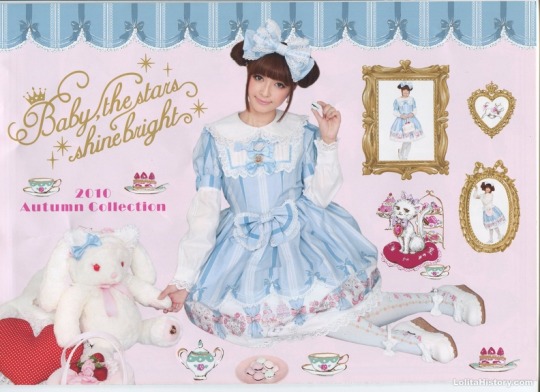
Baby the stars shine bright 2010 autumn collection
♡ lolita today ♡
Although lolita isn't as popular as it once was, it still exists. There are large lolita communities, online and in real life, and some of the brands are still open to this day. In recent years there has been a rising interest in japanese culture in the west. Whether it be through anime or manga, a lot are diving deeper into Japanese culture and fashion. I see lots of people online (typically young people) talking about Japanese street fashion, taking inspiration from fruits and other street fashion magazines, kawaii fashion, gyaru fashion and many more. I think that a part of our generation is trying desperately to go back to slow fashion. I see a lot of teenagers encouraging the consumption of second hand clothing and making things yourself. Maybe this mix of embracing Japanese culture and slow fashion will result in a lolita comeback. I feel like it's happening slowly, with the revival of Japanese street fashion as a whole.
References~
Gothic lolita- lolita wiki
What is Japanese kawaii culture?- the japanese shop
Lolita lifestyle- alternative fashion wiki
The Blog “Lolita tips” on tumblr
What is Otome kei- devilinspired
Classic lolita- lolita wiki
The history of lolita- the comm
History of sweet lolita-rebels market
Lolita fashion- wikipedia
Lace & petticoats by vysanthe pn YT
For pictures-
Lolitahistory.com
29 notes
·
View notes
Text

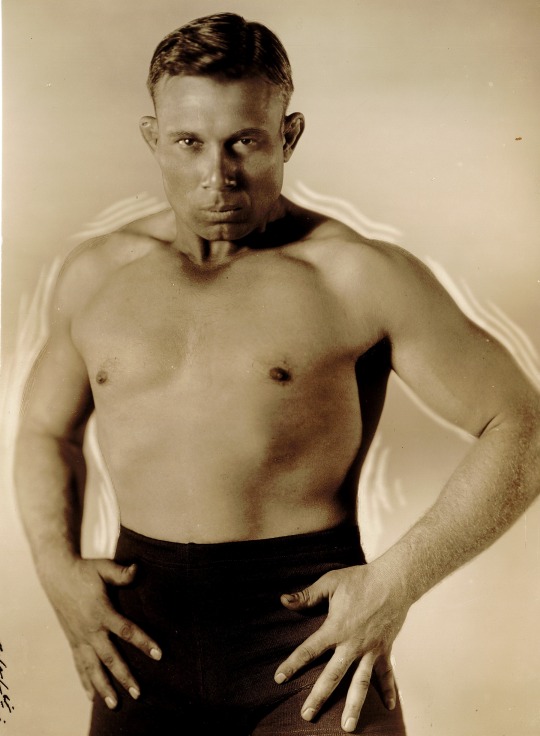
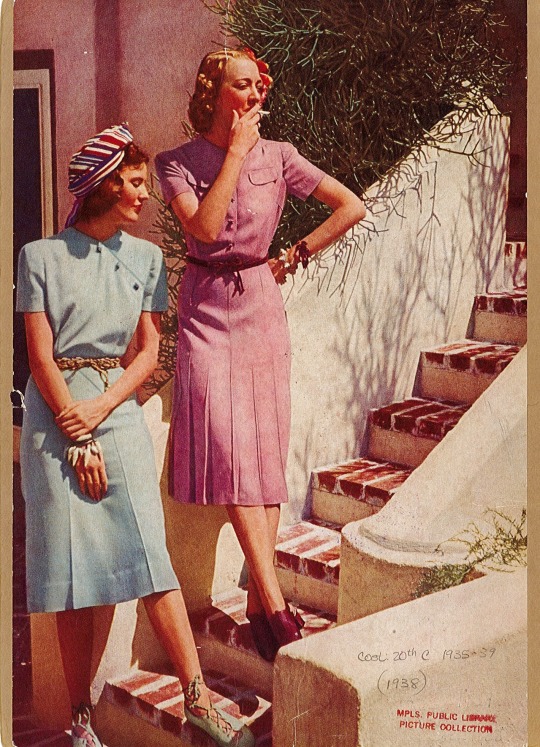

Kitchen Interiors, Bad Roommates, 1930s Costume, and Levitation: Highlights from the Minneapolis Central Library Picture File
A range of cabinets on the 3rd floor of the Minneapolis Central Library hold the library’s Picture File, a collection of 600,000 images—in both color and black and white—sourced from books and magazines between 1895 and 2001. The collection provides a visual history of American culture in the twentieth century, tracking changing trends in fashion, interior design, and advertisement, as well as subjects in the news, reproductions of paintings and photography, and portraits of notable people. Many of these images were never digitized: you won’t find them in a Google image search.
Throughout the years, the Picture File has been a resource for local artists, History Day project students, theater set designers, zine authors, Halloween costume brainstormers, advertising creatives, and others looking for visual inspiration. The library’s annual report of 1943 even noted with pride that librarians from St. Paul Public Library had borrowed material for a children’s exhibit: “the reason for this—the St. Paul Art Department has no such collection of pictures.”
The files, indexed by subject, often reveal surprises. Librarians used the headings to play with meaning and stimulate the visual imagination, asking the question: what is a picture about? The way you read an image can change its focus and draw out new and unseen elements and contexts. The juxtaposition of images in a folder creates new connections: for example, “Everyday Life” groups mid-century advertisements for household appliances next to images of dogs and nuclear families next to the uncanny photography of Diane Arbus and conceptual works by Marina Abramović.
The Picture File contains images rich in local history as well. Clippings from historical Twin Cities publications and non-local photographic prints from the Minneapolis Times photo morgue, complete with original airbrushing, can be found throughout the collection. While most images in the collection can be checked out, folders with Minneapolis-related subject headings have been transferred to Special Collections for safekeeping. And local photos from the newspaper morgue can be found in the Hennepin County Library Digital Collections.
Above images from the Picture File at Minneapolis Central Library:
1. Interiors: Kitchens before 1960
2. Roommates, Bad
3. Costume: 20th Century, 1935-1939
4. Levitation
This post was written by Mark V. from the Art, Music, and Literature department. An exhibit on the Picture File will be on display in the atrium of Minneapolis Central Library for the month of April.
#Minneapolis Public Library#magazines#photographs#graphic design#artist resources#picture files#library collections
47 notes
·
View notes
Text
Book review: Chinese Wallpaper in Britain and Ireland (2017) by Emile de Bruijn

*I wrote this last year but completely forgot to post it. Enjoy the old stock :)
I’ve seen a lot of interesting images from this book on Pinterest so I decided to get the real thing, and I have to say I am extremely satisfied with it. This book is about Chinese made wallpapers from the Qing Dynasty (mostly 18th and early 19th centuries) that were exported to Europe and used as decoration in British and Irish homes. Although wallpapers are an interesting subject on their own, I will only be reviewing it only on the basis of how useful it is for fashion history research. This will be a short one.
Great images
Apparently I was not the only person who got this book for the pictures as the review at the back of the book suggests, and I fully understand why. This book contains high quality photos of Chinese wallpapers from the 18th and 19th centuries, in perfect resolution and colors. Even if you’re not interested in Chinese fashion, I would still recommend you to get this book because it also shows beautiful antique British and Irish interiors and chinoiserie wallpapers, and is just plain pleasant to look at.
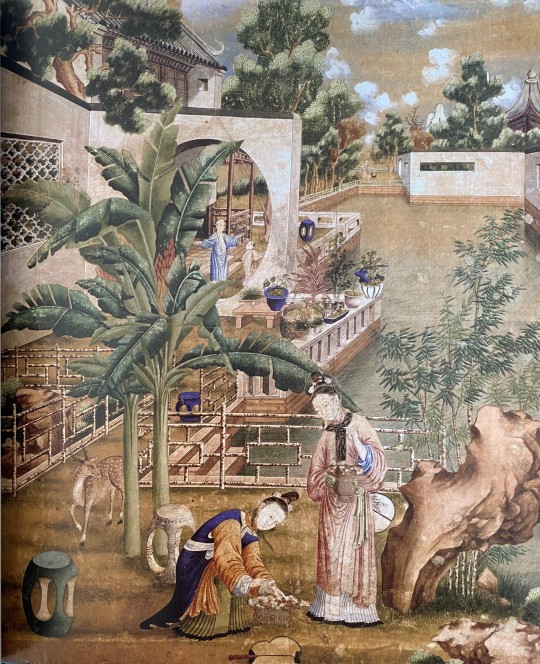
One of my favorites from the entire book, a full page spread with delicious details of a wallpaper depicting a Chinese garden using linear perspective. Even better that the ladies are clad in Qianlong era garments.
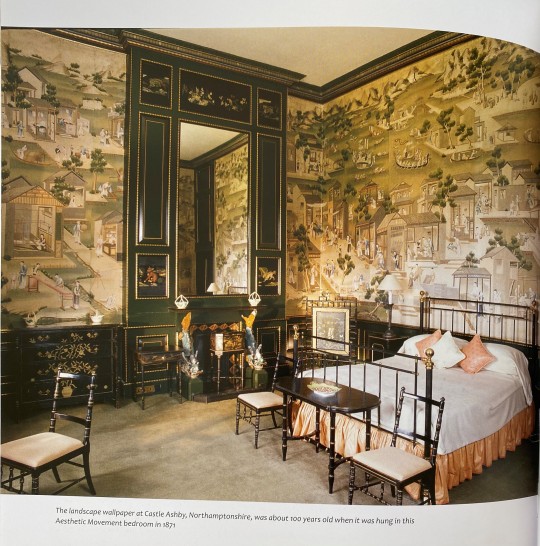
Photos of interiors are also immaculate.
The importance of commercial art
Commercial art like wallpapers, portraits and export paintings is very marginalized in the study of Chinese art, so I highly appreciate that this book sheds more light on a category that traditionally finds absolutely no favor with Chinese art historians. Because of commercialization and increased trade with Europe, popular artworks from this era that depicted life realistically often employed Western painting techniques at least to some extent, meaning they don’t look very Chinese and are often neglected by scholars; more stereotypically Chinese literati painting genres, such as landscape painting or 仕女画 shinvhua (idealized paintings of women) are definitely way more popular among art historians.
Literati painting seldom, if ever, depicted people’s clothing realistically. Costumes were meant to be excessively flowy, adhering to people’s imagination of deities and supernatural beings. Sometimes hints of contemporary fashion could be seen if you know what to look for, because the artist’s imagination had limits and they couldn’t just pull an outfit out of thin air. But still, literati paintings should never be used as resources for the study of fashion history, because the clothing shown had little to no connection to what was popular in real life. Commercial art, on the other hand, depicted real people with real fashion, but is seldom shown in museums or books on Chinese art history because it was considered vulgar and inferior by the literati upper class. In my opinion, commercial art is miles more interesting than literati painting, because literati art has changed relatively little over the course of Chinese history due to conservative Confucian morals, whereas commercial art was usually more reflective of their time and popular tastes. The only non literati Qing painter to ever receive mainstream attention was probably Castiglione, but he was also a court painter and didn’t belong in the commercial category. Even Lam Qua is niche. The commercial export paintings made by native middle class artists of the Guangzhou thirteen factories (十三行), who had more freedom and pioneered new art forms (like reverse glass painting), are rarely discussed.

Literati painting attributed to 焦秉贞 Jiao Bingzhen (active 1689-1726). The costumes of the women, which are extremely stylized and historicist, follow rules of the genre established centuries ago and do not reflect actual fashion. Jiao could paint in the Western style as well, I’m just picking a shinv piece he did. This is the type of stereotypically Chinese art historians love to focus on.

From Chinese Wallpaper, likely made in the late Qianlong era (1770s-1790s). This kind of more down to earth art illustrating everyday life is a lot more rare to see, especially those where the artist attempts Western shading or perspective.
Because “Chinese art” for most people only encompasses literati painting, calligraphy, ceramics and other such stereotypical disciplines, seeing the relative lack of them in the Qing it’s easy to jump to the conclusion that art was not produced with the same rigor as in previous dynasties, which then leads to notions about the Qing being conservative and uncultured and such. No, art was abundant in the Qing, it’s just that the popular taste in art has changed so it was often made in a different medium (oil painting, print and indeed wallpapers) using a combination of Chinese and Western techniques. Scholarship on mediums like oil painting (China trade painting) and reverse glass painting has been virtually nonexistent until very recently; the first thorough monograph of reverse glass painting I’ve read is Thierry Audric’s 2020 Chinese Reverse Glass Painting 1720-1820. I really hope that as research on Qing export art accumulates, it would be able to finally integrate itself into the wider timeline of Chinese art history. So on this matter, thank you de Bruijn for making a whole book on a niche category of Chinese art.
Underrated era
Now with the context out of the way, I can talk about fashion. Although there is no mention of fashion in the text since that isn’t what this book is about, the images included are great for illustrating fashion in the early to mid Qing, which is not well represented in the study of Chinese fashion history at all. I’ve talked multiple times about 18th century erasure on this blog, and I think this book is a very good antidote to that. The bulk of the wallpapers featuring humans were from the Qianlong era (1735-96), a personal favorite era of mine, and there are also several that depict the Jiaqing era (1796-1820), which is even rarer.
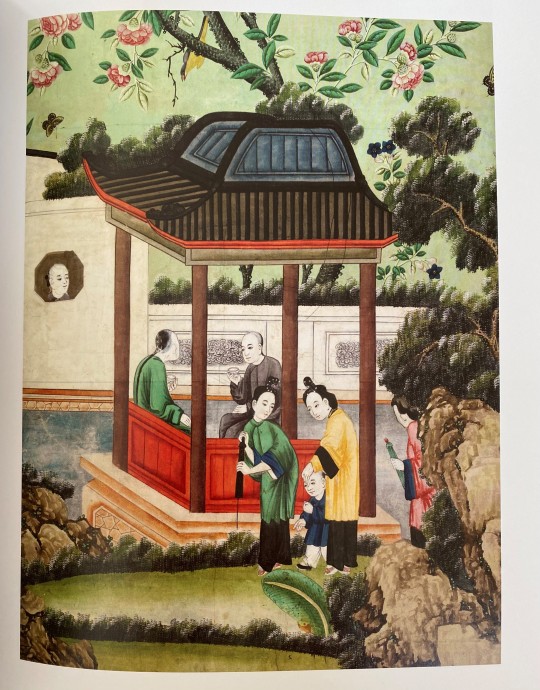
What seems to be Jiaqing era clothing. The unicolor robes with black binding paired with plain black pants or skirts have a very casual and pastoral look. The style is weirdly reminiscent of modern stereotypical “Republican era uniform” Halloween costumes, but way better.
Conclusion/rating
This is a short review because the main point is that this book has plenty of nice images of an underrated era. Without a doubt 9/10. One point off because it would be nicer if the wallpapers are dated, but that’s a minor qualm.
262 notes
·
View notes
Text
I very often wish I was a costume designer. Or a stylist or a photographer. I’ve always been obsessed with fashion history and jewelry and costuming. Sometimes I’ll see, like, photo shoots of women from India in traditional cloths and get a little jealous honestly. They look so incredible, the golds on the jewelry, the intricacies of the garments the accessories the setting and lighting etc. It’s so often so breathtaking. I wish I could do that with Armenian cloths. So often Armenian cloths are presented pretty simply, and if it’s not it’s a model with puffed up lips and a nose job, straightened hair and long ass nails. It seems like Armenian artists who focus on our traditional clothing don’t really look at old photography of women with intricate jewelry and patterns or headdresses and don’t really come up with new and creative ways to present them. I see so much potential and am frequently disappointed artistically.
6 notes
·
View notes
Note
Super Niki au my absolute beloved.. the more information I get the more crazy I get
(hi sorry this sat in the inbox for like two months anon for some reason i was hoping something more substantial would appear out of thin air. it didn't btw.) regardless of that! fuck yeah anon i'm with you on that
i think a superhero niki story would have to have a real focus on the mundane. like the nitty gritty details of "how do you conceal your identity from people in your superhero costume?" "how do you fit patrols into your week? you can't possibly do them every day." all that! again i think this comes back to me being really attached to the 'everyman' side of c!niki it makes me want to imbue that feeling into everything i write with her. in this au i think she does work at a bakery (good for her) but when the shit starts to hit the fan she disengages from her job, stops taking on the extra duties she usually does at work, stops caring, eventually stops showing up. etc. this is probably related to how she ends up crashing with fundy and hbomb after The Puffychu Divorce (superniki edition)
here are a few other miscellaneous thoughts i've been having:
i've been having more of a think about emerald duo in this au, and i think i know how i picture them being. so phil is wilbur's dad, techno is phil's friend, techno and wilbur define their relationship in vastly different ways, etc etc the standard. oh but they're both supervillains. not for any particular reason they kind of liked mucking around causing mayhem first and then came up with an ideology later. anyway phil's retired and techno Would Like to be retired but he's still looped into the job due to Shenanigans (blood god related mb?). wilbur is fully aware of this and goes to him to be like 🥺 help i need ideas when he decides to go supervillain mode
oh! and wilbur's alter ego name is chekhov ^-^
and so the syndicate in this au is......................... a book club. yes for real
okay look i was thinking about what to do with the syndicate and i didn't really want to have them end up as a Bad Ass Villain Posse because i think niki needs to retire or at least be a superperson part time after everything that happens. so instead, she ends up meeting phil and techno and they help her ease into super semi-retirement ^-^ and ofc phil and techno appreciate having another friend who Gets It around. they are literally just like a book club and a mild support group in this au in a very silly way and i like it
i've spoken a bit about fundy and hbomb in this au... yeah niki lives with them after breaking up with puffy. not 100% sure where jack fits in. maybe he's another low ish level vigilante running around and tries to ally with niki? i can't imagine any allegiances she makes in that mental state (without the history she and jack had as l'manbergians in canon) would last very long. maybe she sees a bit of herself in him. they both call each other out for being emotionally immature idiots and then go and do the exact same thing themself. hypocrites
oh and i think i've mentioned niki making her own costume before!! i imagine as a fire based superhero she buys PPE (like from a tradie joint) and modifies it to be 1. functional and 2. fashionable. this does in fact mean that hi-vis yellow + orange are her colours in this au....
and below the cut is a treat: a snippet i wrote of a scene where after a big fight, wilbur finds himself patching up his wounds in the same safety stash as this city's very own friendly neighbourhood superhero (who wants to beat his ass)......
“Why do you hate me?”
The stubborn rasp in his voice surprises even him. As for the woman on the other side of the room, her shoulders draw tight - like a wild animal arching its back, a show of anger.
The question, then – should Wilbur interpret such a motion as defensiveness, or as a threat?
“What makes you say that?” she asks. Her voice runs high with the question – a quiet sound, like a flute's soft alto, though it rasps slightly through the sound of a voice changer. Idly, Wilbur wonders whether it is worth asking where she got it. Or how she fashioned it, perhaps. God knows he needs one. Chekhov might manage perfectly fine in the midst of faceless reporters and supervillains – the proper kind – who haven't seen the light of city streets in years, but if Wilbur were to cross paths with someone he knew as himself (god forbid, someone like Tommy) his voice would give him away quick as anything.
(His heart aches, briefly, when he thinks of his brother.)
Part of him tries to unpick what her voice would sound like without it. It’s difficult not to fixate on these small things – perhaps because the bigger things provide him with so little in comparison. Her voice is quiet, a little difficult to pick the sounds apart around the staticky rumble of the voice changer, but far from timid. There’s a stubborn timbre to it.
(Something in it is familiar. But that thought is patently ridiculous, and Wilbur is impatient, and so it is dismissed.)
[scene continues]
"Am I," Wilbur pauses, wets his lips – it almost feels as if the fire is still flickering beneath his skin, energising and scorching all at once. "Am I that horrible? Is there something – do you see something so inherently terrible in me that you just have to strike it down? Is that it?"
Her powder-keg silence sparks, ignites, her scowl a torn-open slash even beneath the planes of her mask, embroiled in sudden fury. "Don't flatter yourself - "
"Ah, and there it is!" To her credit, she doesn't stagger back as he lights up – if anything, her affect is unimpressed. "Show us the blaze, firebug! What – what drives you? What lights your fuse?"
"Do you even know what you are?" she retorts. Oh, she's caught on the hook, now. "You know what you are?"
What is Wilbur expecting? Proud, arrogant perhaps – delusional wouldn't be anything new, or any of the crueler words from that stock. Wouldn't be the first time he'd been called some variety of son of a bitch bastard, either. Who is he, to this spectre of flame? He's asking honestly, though he doubts she believes in his integrity.
"You're a liar," she continues, words stubborn and fierce and almost unwieldy. "You – you are so selfish, and so cruel – you take, and you take and you take and you don't think for a second of the people you're taking from. You don't think anything of them. You're a liar," and when she repeats these words, they sound like smoke – "and you know what? I hate liars. I hate them."
The words sink into him like stones. How does she know? he asks himself. How does she know?
He doesn't ask her that. Knowing his patience, he'd be lucky for an answer, anyway - instead he just suggests, "you speak like you're familiar on the subject, then?"
If it's even possible, her scowl drives itself deeper into her face - like tyre tracks driven into mud, an ugly slash of drawn brows and what he can only assume is teeth bared behind that voice changer of hers.
She looks at him like he isn't worth a single thing on this earth.
"Yeah, well," she spits. "I've had my fair share, with bastards like you."
#thank u nonnie!!#sorry bout the wait you know how it is around these parts#ive been so considering writing a puffychu and a rainduo scene from this au ngl. i think it would be fun#aunonnies#superniki
11 notes
·
View notes
Text
Do you ever look at how you analyze media and go ‘huh. Well my upbringing affects this analysis substantially. Ok’
Because I‘be been watching the original doctor who and All I See Are Sets And Costuming. Like I’m following and enjoying the narrative, truly. However the costuming and sets and makeup are so significant to me in how I enjoy the story.
And it’s like, oh. My mom went to school for Costuming and spent significant time studying fashion history. I grew up with a shoe-sized textbook on the history/different types of shoes, which she got partially because of that cute size-of-subject detail, and partially because she was fascinated by the subject matter and the fact that the photos and drawings in the book was almost all to scale. This is the one I mention because it’s the one I could reach on her shelf and flip though most easily, and tbh I really liked shoes when I was little(still do, but not as aggressively) but she has three shelves of the book space in her sewing room holding textbooks about drafting(historical and modern) practicality of different clothing items in different situations, where and when certain clothing items and styles existed and were popular, just all the ‘how’s and ‘why’s and ‘when’s of clothes being what they were. She gave me a book on natural dyeing(which I keep in my reference shelf) when she realized she’d never use it and heard me mention being interested in the array of color in natural dyes, and how most things are likely synthetically dyed. She already had a book in the process of making and using natural dyes, and gave it to me and it lives on my reference shelf. She worked in Live Theatre for a while and helped with props when needed, and had a focus on if things made sense for the time the shows were in.
And while watching Dr Who, my first thought with every outfit I see is ‘does that make sense for the situation.’ And I love that. I love that lens she’s created and how you can see that so well. Maybe I’m not good at drawing clothes yet, maybe I don’t have her encyclopedic knowledge of fashion history and have fun mixing eras in my head. But the practicality of costuming and how it’d be made is something I see and pay attention to, and I’m so glad that I have that. Yeah, she messes up, and I’m not sure if I want to stay in contact with her after college. But I’ll always have that lens when watching shows or reading comics, and it’s like a little ‘I love you’ from her, and a lovely reminder of what I think is one of the most genuine parts of our relationship.
I dunno. I just think it’s worth thinking about and talking about how things influence us and how we feel about that influence. And while I want to shake of some of the things she’s influenced in my being, this is one thing I want to keep.
3 notes
·
View notes
Text

Purim: Not to speak is to speak
I'm seeing lots of pictures of Purim costumes and parties. Those are nice but the weight of the focus on costumes makes me wonder how many people remember (much less teach) the highly important and very relevant lessons of Purim.
Purim might seem frivolous but it isn't.
Jewish holidays can be fun but they aren't for fun, they are for teaching, remembering, and becoming stronger by being wiser, learning from those who came before us.
Purim is a celebration of the Holocaust that wasn't. That is something super worthy of celebrating - and if we don't remember why we are celebrating we won't learn from the past and it is super likely to repeat itself.
Purim is a nice story. A feel-good, Jewish-people-saved-from-destruction win-in-the-end kind of story.
Most Jews find their way to at least one Megilla reading, toss on a fashion statement to get into the spirit, and enjoy the seudah and celebrations. But how many of us spend the time to actually contemplate the story and what it means? Is something that happened approximately in 357 BCE relevant today?
Most of us think of the holiday as a nice folk-story, a fun holiday for kids. We put most of our effort into costumes for the kids, what goes in the mishloach manot and who is having a party. Like many of the holidays, it’s easy to overlook the profound message of Purim.
The stories of Israel are told for a purpose. Many serve as a reminder of events that occurred during the history of our People. All convey lessons that teach us principles and values that shape the identity of the Jewish tribe and do not diminish in relevancy over time.
Purim is no different. An attempt to exterminate the Jewish people, more than two thousand years ago – the Jewish people would not have survived to see the Holocaust had this ancient attempted genocide been successful.
“In every generation, they rise up to exterminate us and every time, God saves us from their hands”
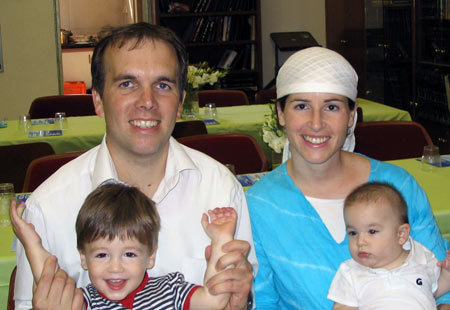
Roy Klein saved the lives of his soldiers by throwing himself on a grenade, choosing their lives over his
The Jewish experience of persecution and survival span the ages and bond between generations. Considered in this light, Purim has a much more profound significance than dressing up and making noise at Haman’s name, sending mishloach manot or even considering the philosophical/religious question of where God was during this event.
Purim has a message very relevant for Jews today: Not to speak is to speak.
Read More: Here
26 notes
·
View notes